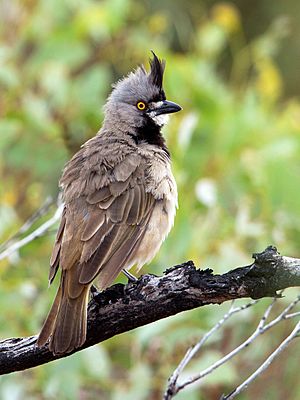Crested bellbird facts for kids
Quick facts for kids Crested bellbird |
|
|---|---|
 |
|
| Conservation status | |
| Scientific classification |
The crested bellbird (Oreoica gutturalis) is a medium-sized bird found in Australia. It lives in dry areas like scrublands, woodlands, and sandy plains. This bird is famous for its unique bell-like call, which can be heard from far away!
Male bellbirds are about 20 cm (8 inches) long. They have a grey head, a black crest, and a black chest. Their body is grey or olive brown. Females and young birds look similar, but their colors are softer. They also don't have the black chest.
Crested bellbirds eat seeds and small insects. They look for food on the ground or in low bushes. Their nest is shaped like a deep cup. It's usually built low to the ground, often in a tree fork or a stump. Both parents help to hatch the eggs. While this bird is common in many places, its home is shrinking in some areas, like Victoria.
Contents
About the Crested Bellbird's Name
The crested bellbird has a scientific name, Oreoica gutturalis. Its aboriginal name, panpanpanella, sounds like its bell-like voice. Early European settlers also called it dick-dick-the-devil because of its unique call.
What Does a Crested Bellbird Look Like?
Adult bellbirds are usually between 19 cm and 23 cm (7.5 to 9 inches) long.
- Males: They have grey heads with a black crest that can stand up. They also have a white forehead and throat, and a clear black patch on their chest. The rest of their body is grey or brown.
- Females and Young Birds: They are not as brightly colored as the males. They don't have the black chest patch. Their black crest is smaller and doesn't stand up as much.
Both male and female bellbirds have orange-red eyes. Other birds that look a bit like the crested bellbird include wedgebills and the Western whipbird.
How Crested Bellbirds Behave
Building Nests and Raising Young
During breeding season, crested bellbirds form pairs. They build deep, cup-shaped nests. These nests are made from small sticks and twigs. They are lined with soft materials like fine bark or leaves. Nests are often found in tree forks or hollow stumps. They are usually less than two meters (6.5 feet) off the ground.
Both parents take turns sitting on the eggs to keep them warm. The breeding season usually runs from August to December. A pair will lay one to four eggs. The eggs are white or light blue. They have small dark brown and grey spots.
A cool fact about their nests: bellbirds sometimes place caterpillars around their nest! They nip the caterpillars' necks to make them still. Scientists think they might do this to save food for their babies. Or, the hairy caterpillars might act like a spiky fence to protect the young birds.
What Crested Bellbirds Eat
Crested bellbirds eat small insects and seeds. They move quickly, hopping on the ground. They also fly low between small bushes or into the lower branches of trees to find food. They usually look for food alone. But during breeding season, they might feed in pairs. Sometimes, they even join groups of other birds, like chestnut-rumped thornbills and red-capped robins.
The Bellbird's Amazing Voice
The crested bellbird has a very special call. It sounds like a high-pitched bell. It often makes two slow notes, then three fast notes, like 'did-did-did-dit.' Male birds sing from high spots, like a dead branch or the top of a tree.
Sometimes, you can hear a male and female singing together. The male makes a 'tik-tik-tik' sound, and the female answers with a bell-like 'tonk-tonk.' Even though the bird itself can be hard to spot, the male's call can be heard from over half a kilometer (a third of a mile) away!
Another cool thing about the bellbird's call is that it's a bit like ventriloquism. This means it can be very hard to figure out where the sound is coming from. One moment it sounds like it's to your left, then to your right, then behind you!
Where Crested Bellbirds Live
Crested bellbirds live in the drier parts of Australia. You can find them along the semi-arid coastlines and further inland. They especially like areas with acacia scrublands, eucalypt woodlands, and plains with spinifex or saltbush plants.
These birds usually stay in one area. They are found across most of Australia. This includes west of the Great Dividing Range, in southern tropical northern Australia, and through South Australia to the west coast of Western Australia. Bellbirds avoid the far north, the very wet eastern areas, and the extreme southwest. In Victoria, the species is listed as threatened. It has disappeared from more than half of its original home there.
Protecting the Crested Bellbird
The number of crested bellbirds has gone down in some areas. This is mainly because their habitat is being destroyed by land clearing. These birds are very sensitive to their homes being broken up into smaller pieces.
The crested bellbird is not listed as threatened under Australia's main environmental law. However, its conservation status can be different in each Australian state. For example:
- In Victoria, the crested bellbird is listed as threatened under the Flora and Fauna Guarantee Act (1988). This means it needs special protection.
- On Victoria's 2007 list of threatened animals, the crested bellbird was listed as near threatened. This means it could become threatened in the future.
See also
 In Spanish: Silbador campanillero para niños
In Spanish: Silbador campanillero para niños


